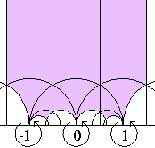Mark
Ronan has written a beautiful book intended for the general public
on Symmetry and the Monster. The
book’s main theme is the classification of the finite simple groups. It
starts off with the introduction of groups by Galois, gives the
classifivcation of the finite Lie groups, the Feit-Thompson theorem and
the construction of several of the sporadic groups (including the
Mathieu groups, the Fischer and Conway groups and clearly the
(Baby)Monster), explains the Leech lattice and the Monstrous Moonshine
conjectures and ends with Richard Borcherds proof of them using vertex
operator algebras. As in the case of Music of the
Primes it is (too) easy to be critical about notation. For example,
whereas groups are just called symmetry groups, I don’t see the point of
calling simple groups ‘atoms of symmetry’. But, unlike du Sautoy,
Mark Ronan stays close to mathematical notation, lattices are just
lattices, characer-tables are just that, j-function is what it is etc.
And even when he simplifies established teminology, for example
‘cyclic arithmetic’ for modular arithmetic, ‘cross-section’
for involution centralizer, ‘mini j-functions’ for Hauptmoduln
etc. there are footnotes (as well as a glossary) mentioning the genuine
terms. Group theory is a topic with several colourful people
including the three Johns John Leech, John
McKay and John Conway
and several of the historical accounts in the book are a good read. For
example, I’ve never known that the three Conway groups were essentially
discovered in just one afternoon and a few telephone exchanges between
Thompson and Conway. This year I’ve tried to explain some of
monstrous moonshine to an exceptionally good second year of
undergraduates but failed miserably. Whereas I somehow managed to give
the construction and proof of simplicity of Mathieu 24, elliptic and
modular functions were way too difficult for them. Perhaps I’ll give it
another (downkeyed) try using ‘Symmetry and the Monster’ as
reading material. Let’s hope Oxford University Press will soon release a
paperback (and cheaper) version.
Tag: Borcherds

Yesterday morning I thought that I could use some discussions I had a
week before with Markus Reineke to begin to make sense of one
sentence in Kontsevich’ Arbeitstagung talk Non-commutative smooth
spaces :
It seems plausible that Borcherds’ infinite rank
algebras with Monstrous symmetry can be realized inside Hall-Ringel
algebras for some small smooth noncommutative
spaces
However, as I’m running on a 68K RAM-memory, I
didn’t recall the fine details of all connections between the monster,
moonshine, vertex algebras and the like. Fortunately, there is the vast
amount of knowledge buried in the arXiv and a quick search on Borcherds gave me a
list of 17 papers. Among
these there are some delightful short (3 to 8 pages) expository papers
that gave me a quick recap on things I once must have read but forgot.
Moreover, Richard Borcherds has the gift of writing at the same time
readable and informative papers. If you want to get to the essence of
things in 15 minutes I can recommend What
is a vertex algebra? (“The answer to the question in the title is
that a vertex algebra is really a sort of commutative ring.”), What
is moonshine? (“At the time he discovered these relations, several
people thought it so unlikely that there could be a relation between the
monster and the elliptic modular function that they politely told McKay
that he was talking nonsense.”) and What
is the monster? (“3. It is the automorphism group of the monster
vertex algebra. (This is probably the best answer.)”). Borcherds
maintains also his homepage on which I found a few more (longer)
expository papers : Problems in moonshine and Automorphic forms and Lie algebras. After these
preliminaries it was time for the real goodies such as The
fake monster formal group, Quantum vertex algebras and the like.
After a day of enjoyable reading I think I’m again ‘a point’
wrt. vertex algebras. Unfortunately, I completely forgot what all this
could have to do with Kontsevich’ remark…
